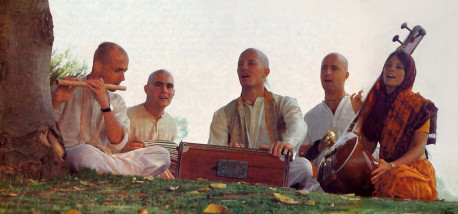Hare Krsna Hare Krsna Krsna Krsna Hare Hare
Hare Rama Hare Rama Rama Rama Hare Hare
Q. What are the instruments I see the Krsna people playing when they chant in the streets?
A. When the chanters go out into the streets, they play the mrdanga (which in Bengali means “the drum you can walk with”) and karatalas, small hand cymbals. Five centuries ago Lord Caitanya and His followers traveled through India’s towns and villages and chanted to the accompaniment of these same instruments. The traditional drums are made of clay and break quite easily, so it has proven a wise idea to manufacture them out of fiberglass. In quieter settings chanters may also play the harmonium (a hand-pumped organlike instrument) and the tamboura (a stringed drone instrument).
His Divine Grace A.C. Bhaktivedanta Swami Prabhupada, the founder-acarya of the International Society for Krishna Consciousness, was especially fond of the mrdanga and karatalas, and he personally taught his disciples how to play them. As the famed poet Srila Visvanatha Cakravarti Thakura wrote three centuries ago, “The spiritual master is always happy to chant the Lord’s names, dance in ecstasy, and play musical instruments for the Lord’s pleasure.”
Q. When I meditate I want to experience higher energy levels. Does chanting Hare Krsna help you do this?
A. Yes. Actually, everything we experience is simply a combination of the Supreme Lord’s energies. Krsna has three principal energies. First there’s the spiritual energy, which is eternal and full of knowledge and bliss. Then there’s the material energy, which is temporary and full of ignorance and distress. Between these two is the Lord’s marginal energy, which is made up of the living beings (ourselves) who emanate from Him. Our situation is that we can be in contact with either the material energy or, the spiritual energy, and according to the choice we make, we experience either recurring material discomforts (like disease, old age, and rebirth) or eternal spiritual pleasure. By chanting Hare Krsna we can again experience the eternal knowledge and bliss of the spiritual energy, actually, Lord Krsna has invested all His spiritual energy in the Hare Krsna maha-mantra.
Q. What’s the best time of day to chant Hare Krsna?
A. Lord Caitanya said we should always chant Krsna’s names—twenty-four hours a day. If that’s not possible, then chant whenever you can; there are no hard and fast rules.
Q. Why chant “Krsna”? Why not just say “God, God”?
A. The word “president” describes the highest post in a country or company, but don’t we want to know the name of the person who occupies the post? In the same way, the word “God” describes the highest of all posts, that of the supreme controller, but don’t we want to know His name? The Vedic literatures tell us that God’s original name is Krsna. Of course, God has many other names—such as Govinda, Yahweh, Jehovah, and Allah—but Lord Caitanya (the incarnation of God for this age, who appeared in India in 1486) recommended the chanting of Hare Krsna.
Q. Isn’t it limiting God to call Him by a name?
A. Actually, isn’t it limiting God not to call Him by a name? All of us have names, so why shouldn’t He? As the Vedic literatures explain, God has millions of names, but Krsna (“the all-attractive one”) is the most universal.
Q. Will chanting Hare Krsna put you in samadhi?
A. First of all we might ask, “Just what is samadhi” As the Bhagavad-gita explains, “Samadhi, or trance, is the state in which one completely restrains his mind from material mental activities by practice of yoga. In that joyous state, one is situated in boundless transcendental happiness and enjoys himself through transcendental senses, in his relationship with the Supreme.”
The yoga of chanting Hare Krsna is the easiest and most practical way to attain samadhi in the present age. Anyone, even a child, can chant Hare Krsna. All you have to do is focus your mind on the transcendental sound vibration of the maha-mantra, and you’ll absorb your consciousness in the Supreme, which is the same result that hatha-yogis formerly achieved after much difficulty,
In ages gone by, a hatha-yogi would go to the forest and hold difficult postures for many years so that he could focus his attention on the Lord in his heart. Of course, this is hardly possible for us today; a lotus posture makes us uncomfortable after only a few minutes. But you can chant Hare Krsna for hours, whether you’re standing, walking, sitting, dancing, or whatever.
No matter what you’re doing, the maha-mantra keeps your mind in spiritual consciousness, Krsna consciousness. And this is samadhi.


Leave a Reply